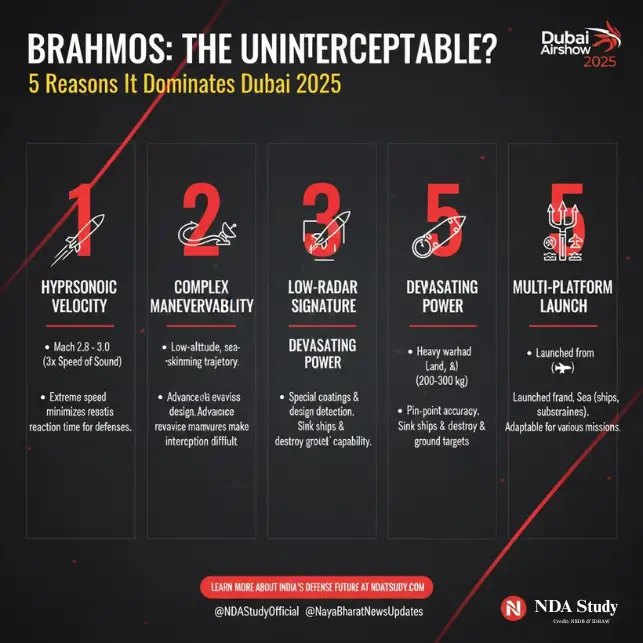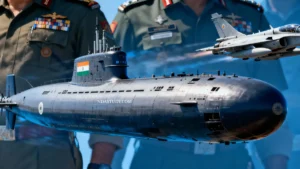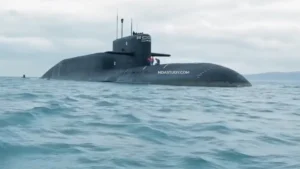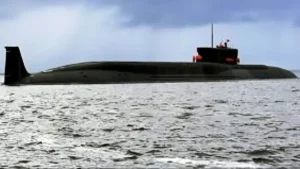India just rewrote the rules of missile warfare. On May 7-10, 2025, during Operation Sindoor, India unleashed something unprecedented: the BrahMos supersonic cruise missile in real combat. For the first time in 20+ years of development, the India-Russia joint venture missile proved its legendary status.
The result? Pakistan’s entire air defense network failed completely.
Now, six months later at Dubai Airshow 2025, the missile that Pakistan couldn’t stop has become the most sought-after defense system on the global market. Vietnam, Indonesia, Thailand, UAE—everyone wants BrahMos. Why? Because Operation Sindoor wasn’t theory. It was devastating proof.
This is the story of how combat success created a geopolitical game-changer.
5 TECHNICAL REASONS WHY BRAHMOS IS TRULY “UNINTERCEPTABLE”
Here is the research and analysis conducted by the NDA Study Defence Bureau (NSDB) and the Infowire Defence Research & Analysis Wing (IDRAW) on Top 5 Technical reasons, Why BrahMos is truly Uniterceptable?

Reason #1: Mach 2.8-3 Speed = The Interception Trap 🎯
Here’s the problem: Fighter jets and air defense missiles were designed in the 1970s-1990s. BrahMos travels at Mach 2.8-3—that’s 3,200+ km/h. Pakistani and Chinese fighter jets max out at Mach 2.2-2.5. Translation? BrahMos is 15-40% FASTER than the systems designed to stop it.
During Operation Sindoor, BrahMos covered 290 km in just 6 minutes. Pakistani air defense had maybe 90 seconds to detect, track, and respond. Their systems? Designed for subsonic threats with 20-30 minute engagement windows. Even Pakistan’s most advanced HQ-9/P air defense missile needs 45-60 seconds just to launch. By then, BrahMos had already hit its target.
The math is ruthless: Interception = impossible at those speeds.
Reason #2: Sea-Skimming Flight Path = Radar Blind Spot 🛡️
BrahMos has a secret trick: it flies at 10 meters above the ground.
Think about it. Traditional air defense radars scan the sky upward. They’re programmed to track aircraft at 5,000+ meters altitude. But BrahMos? It hugs the terrain—literally skimming above water or ground at single-digit meter heights.
This creates a radar dead zone.
Pakistan’s Erieye AEW&C radar (mounted on aircraft) is designed to spot fighter jets, not low-flying cruise missiles. It literally can’t look down fast enough to track something traveling at ground level at Mach 3. Even if detected, BrahMos performs 15-20 degree course corrections in its terminal phase. Imagine trying to hit a bullet moving sideways at 3x the speed of sound. Impossible.
Pakistani air defense operators literally had no solution for this flight profile.
Reason #3: Pinpoint Accuracy (CEP 1-3m) = Hit Probability 95%+ 📍
Accuracy wins wars. BrahMos doesn’t just fly fast—it hits exactly where it’s supposed to.
Circular Error Probability (CEP): 1-3 meters. That means 50% of BrahMos missiles land within 3 meters of their target.
Compare that to subsonic cruise missiles: 10-15 meter CEP.
During Operation Sindoor, satellite images showed BrahMos missiles creating direct hits on runways at Pakistan’s Sargodha, Nur Khan, and Rafiqui airbases. We’re talking precision to the meter level. Here’s what makes it worse for Pakistan: BrahMos uses INARS guidance (Inertial Navigation + Active Radar Seeker). Once locked on a target, it’s “fire and forget”—no communication link needed. Pakistani electronic warfare couldn’t reprogram or jam the missile mid-flight.
Hit probability: 95%+. Even if Pakistan detected it, stopping it was a different animal.
Reason #4: Multi-Launch Saturation = Defense Overwhelmed 💥
Pakistan had a fatal assumption: They could handle a few missiles.
:- Wrong.
During Operation Sindoor, 12+ BrahMos missiles were fired simultaneously across 8 Pakistani airbases within a 500 km area.
Pakistan’s air defense: Sequential engagement. One target at a time.
12 simultaneous threats vs. capacity for maybe 2-3 concurrent engagements = system saturation.
It’s like throwing 12 punches when your opponent can only block 2. The third punch, the fourth, the fifth—they all land. Each Su-30MKI fighter jet carries one BrahMos. Multiple jets meant multiple simultaneous launches from different angles and altitudes. Pakistan’s defense had to track them, calculate intercept solutions, and launch counter-missiles—all in 90 seconds.
Impossible. The system broke under saturation.
Reason #5: Liquid Ramjet Engine = Thermal Signature Mystery 🔥
This is the classified advantage nobody talks about openly.
Most cruise missiles use solid rocket boosters—conventional thermal signature that infrared systems “know.”
BrahMos? Liquid-fueled ramjet engine. A completely different thermal fingerprint.
Here’s why it matters: Pakistan and China rely heavily on IR (infrared) tracking systems for defense. These systems are trained to recognize solid rocket thermal patterns. But BrahMos’ liquid ramjet engine produces a variable thermal signature that doesn’t match their database.
Result? Thermal imaging systems can’t reliably lock on.
Only India and Russia have mastered liquid supersonic cruise missiles. (The US doesn’t even have one.) This exclusive technology means Pakistan’s thermal defense systems were chasing a ghost—an engine signature they’d never encountered before. India’s classified engine cooling and thermal management tech made detection exponentially harder. Pakistan’s systems literally weren’t designed for this.
Dubai Airshow 2025: Why Everyone Now Wants BrahMos
Flash forward to November 2025. The Dubai Airshow opened on November 17. By November 21, something extraordinary happened: BrahMos became the most sought missile at the entire airshow.
Why the spike?
Operation Sindoor changed everything.
Suddenly, BrahMos wasn’t theoretical. It was battle-proven. India’s DRDO proved the “uninterceptable” claim with real-world combat footage and satellite imagery. Pakistan tried to claim interception; satellite images proved otherwise.
Global buyers took notice.
Who Wants BrahMos Now?
- 🇵🇭 Philippines: Already signed contracts; deliveries happening now
- 🇻🇳 Vietnam: Negotiating actively (anti-China deterrent for South China Sea)
- 🇮🇩 Indonesia: Exploring maritime security applications
- 🇦🇪 UAE: First Gulf nation discussing deep integration
- 🇹🇭 Thailand, Malaysia: Formal inquiries on the table
The common thread? All face Chinese maritime pressure. BrahMos became their insurance policy—a proven system that Pakistan’s allies couldn’t stop.
At Dubai, BrahMos Aerospace director Praveen Pathak confirmed: “Demand has skyrocketed post-Operation Sindoor.” The Philippines contract is already proving India can execute complex missile exports. Now, Vietnam and Indonesia see their chance.
This is India's defense export revolution in real-time.Tejas Crashed, But BrahMos Dominated: Dubai’s Tale of Two Moments
The Dubai Airshow was supposed to be India’s flying showcase. The HAL Tejas fighter jet was center stage—India’s homegrown 4.5-generation combat aircraft. Then, on November 21, tragedy struck. The Tejas crashed during a demonstration sortie. The pilot suffered fatal injuries. Thick black smoke rose above the runway. Spectators watched in horror. It should have been a dark moment for Indian defense.
Instead, something unexpected happened: BrahMos stole the spotlight.
While Indian media initially focused on the Tejas tragedy, defense analysts and global buyers redirected attention: “Yes, Tejas crashed. But BrahMos? That system is unstoppable.” The contrast tells a story about modern warfare, Missiles matter more than fighters.
In Operation Sindoor, a handful of Su-30MKI fighters (carrying BrahMos) accomplished what would have taken dozens of dogfighting aircraft to achieve. Undetectable, unstoppable, precision strikes from 290 km away.
The fighter jet crashed; the missile system’s reputation soared.
Geopolitically, this shift—from aviation-centric to missile-centric deterrence—signals that precision strikes now define modern conflict, not air superiority. Dubai 2025 hammered that lesson home.
Related Articles Worth Exploring:
Tejas Fighter Jet Crashes at Dubai Air Show 2025: No official …
Colombia Fighter Jet Deal: €3.1B Gripen-E Contract Exposed
10 Reasons Why Exercise Malabar 2025 Is Breaking All Records (Fact #7 Will Shock You)
7 Most EXPLOSIVE India-Vietnam Defence Partnership Breakthroughs VINBAX 2025 Revealed
DRDO tested K-5 SLBM Stage-2 Motor Successfully: India’s Nuclear Triad Sea-Leg Breakthrough
FAQs | Why BrahMos Became Top-Sought & Dubai Airshow 2025
1. Is BrahMos Really “Uninterceptable”?
According to DRDO’s Ex-Director-General Dr. Sudhir Kumar Mishra, yes. During Operation Sindoor, zero successful intercepts occurred. Pakistan’s air defense system couldn’t track or stop a single BrahMos missile. Modern interception systems are designed for subsonic threats (1970s-90s tech), not Mach 3 hypersonic missiles. Uninterceptable? Latest research and analysis conducted by the NDA Study Defence Bureau (NSDB) and the Infowire Defence Research & Analysis Wing (IDRAW) suggests BrahMos is truly Uniterceptable? ” The evidence suggests yes.
2. Why Did Pakistan Fail to Stop BrahMos in Operation Sindoor?
Multiple factors:
(1) Mach 3 speed exceeded interceptor missile capabilities,
(2) Sea-skimming flight evaded radar,
(3) 6-minute engagement window too short for defense response,
(4) Saturation attack (12+ simultaneous launches) overwhelmed sequential defenses,
(5) Thermal signature unfamiliar to IR systems. Pakistani defenses were simply outmatched.
3. Which Countries Are Now Buying BrahMos?
Philippines (active contracts), Vietnam (negotiating), Indonesia (exploring), UAE (discussions ongoing), Thailand and Malaysia (formal inquiries). All buyers cite South China Sea security and need for proven anti-ship deterrence. Combat proof from Sindoor was the tipping point.
4. How Does BrahMos Compare to American Tomahawk Missiles?
BrahMos is supersonic (Mach 3) vs. Tomahawk’s subsonic (Mach 0.73). Mach 3 means targets have 6 minutes vs. 30+ minutes to respond. BrahMos uses liquid ramjet (India-Russia exclusive); US has no equivalent. BrahMos is shorter-range (290km export vs. Tomahawk’s 1,000km) but faster and more maneuverable. For coastal/maritime defense, BrahMos is superior. For long-range strategic strikes, Tomahawk wins.
5. Will the Tejas Crash Affect BrahMos Sales at Dubai?
No. Analysts report BrahMos demand actually increased because the Tejas crash highlighted aviation risks, while BrahMos’ proven reliability became more attractive. Modern warfare favors unmanned/autonomous systems over manned aircraft. BrahMos sits at the intersection of automation + lethality + proven performance, says NSDB & IDRAW‘s report.
6. Can NDA Officers Work with BrahMos Systems?
Yes. Indian Navy and Air Force officers get postings at BrahMos Aerospace facilities in Delhi and Mumbai. Career opportunities include missile systems integration, export coordination, combat doctrine development, and training. As India’s premier missile platform, BrahMos represents cutting-edge defense tech careers for NDA graduates.
The Future: BrahMos 2.0 & Hypersonic Evolution
Dubai 2025 isn’t the end of the BrahMos story—it’s the beginning of the next chapter.

Note: You Can Check your Age Eligibility via our NDA Age Calculator and BMI Calculator for Physical standard etc.
In Development:
- BrahMos-ER (Extended Range): 450-800 km range (vs. current 290 km export version)
- BrahMos-2: Hypersonic variant (Mach 5-7)—next-generation threat to air defense
- BrahMos-MA: Submarine-launched variant for underwater stealth deployment
India is also racing to integrate BrahMos with unmanned aerial vehicles (UAVs) and developing anti-ship variants for littoral combat. The geopolitical race heats up: Russia’s Kinzhal (Mach 10+), US Tomahawk upgrades, and China’s YJ-21 (anti-ship variant). But BrahMos’ combat-proven status gives it first-mover advantage in the export market.
How A Single Operation Rewrote India’s Defense Exports
Operation Sindoor wasn’t just a military strike. It was a proof-of-concept event that transformed BrahMos from a theoretical superweapon into a battle-tested export phenomenon.
At Dubai Airshow 2025, BrahMos became the missile that Pakistan couldn’t stop—and now, the missile every defense ministry wants. Vietnam and Indonesia see it as their shield against Chinese expansion. UAE views it as gateway to next-generation deterrence. Philippines cemented their choice with actual operational deployment.
India’s message is clear: We are no longer just arms buyers. We are precision weapon exporters.
While the Tejas aircraft crashed on the tarmac, the BrahMos missile soared in global demand. That’s the new equation of power: missiles + autonomy + combat proof = game-changer.
For NDA aspirants watching this unfold: India’s defense revolution needs your skills. BrahMos Aerospace, HAL, DRDO—these organizations are hiring engineers, strategists, and officers to build the next generation of indigenous systems.
India’s missile era has begun. Dubai 2025 was just the opening act. 🚀












